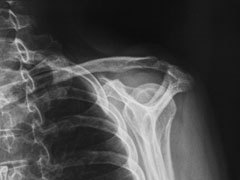Anaesthetic Technique Reduces Pain, Complications
Sunnybrook is reducing pain and minimizing respiratory complications for patients receiving shoulder surgery with a new technique that uses ultrasound guidance to visualize and place local anaesthetic.
Using ultrasound guidance, an interscalene brachial plexus block (a special nerve block) delivers a low volume of local anaesthetic for shoulder surgery. This avoids interference with vital structures, and provides excellent pain relief with minimal respiratory complications in patients who are elderly, overweight or have pulmonary issues.
Traditional techniques (without ultrasound guidance) resulted in high incidences of phrenic nerve (a nerve that originates in the neck region of the spine) paresis, whereas techniques using an interscalene brachial plexus block relieve pain by interrupting how pain signals are sent to the brain.
"Previously, patients who were more elderly, overweight or had lung disease were not good candidates for shoulder surgery because there was a high incidence of paralysis of the breathing muscle on one side of the chest leading to risk of postoperative respiratory problems," says Dr. Colin McCartney, an anesthesiologist at Sunnybrook's Holland Orthopaedic and Arthritic Centre. "This technique is opening new doors for patients who have faced years of discomfort from shoulder pain."
One of the key problems for patients who have medical problems or are overweight is that not only does the traditional method of delivering a nerve block pose a risk, but receiving general anaesthesia and narcotic pain medication also places them at risk for complications.
"Until we demonstrated the ability to combine both effectiveness and avoidance of side effects with the new low volume nerve block technique, these patients had no good anaesthetic or pain relief options for shoulder surgery," says Dr. McCartney.
PDF / View full media release »



